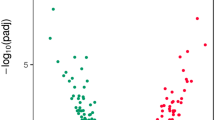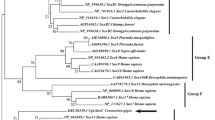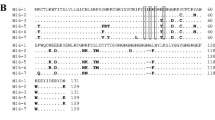Abstract
Left-right (L-R) asymmetry is controlled by gene regulation pathways for the L-R axis, and in vertebrates, the gene Pitx2 in TGF−β signaling pathway plays important roles in the asymmetrical formation of organs. However, less is known about the asymmetries of anatomically identical paired organs, as well as the transcriptional regulation mechanism of the gene Pitx in invertebrates. Here, we report the molecular biological differences between the left and right mantles of an invertebrate, the Pacific oyster Crassostrea gigas, and propose one possible mechanism underlying those differences. RNA sequencing (RNA-seq) analysis indicated that the paired organs showed different gene expression patterns, suggesting possible functional differences in shell formation, pheromone signaling, nerve conduction, the stress response, and other physiological processes. RNA-seq and real-time qPCR analysis indicated high right-side expression of the Pitx homolog (cgPitx) in oyster mantle, supporting a conserved role for Pitx in controlling asymmetry. Methylation-dependent restriction-site associated DNA sequencing (MethylRAD) identified a methylation site in the promoter region of cgPitx and showed significantly different methylation levels between the left and right mantles. This is the first report, to our knowledge, of such a difference in methylation in spiralians, and it was further confirmed in 18 other individuals by using a pyrosequencing assay. The miRNome analysis and the TGF-β receptor/Smad inhibition experiment further supported that several genes in TGF−β signaling pathway may be related with the L/R asymmetry of oyster mantles. These results suggested that the molecular differentiation of the oyster’s paired left and right mantles is significant, TGF−β signaling pathway could be involved in establishing or maintaining the asymmetry, and the cgPitx gene as one of genes in this pathway; the different methylation levels in its promoter regions between L/R mantles was the one of possible mechanisms regulating the left-right functional differentiation.





Similar content being viewed by others
References
Aguilera F, Mcdougall C, Degnan BM (2014) Evolution of the tyrosinase gene family in bivalve molluscs: independent expansion of the mantle gene repertoire. Acta Biomater 10:3855–3865
Anders S, Huber W (2012) Differential expression of RNA-Seq data at the gene level—the DESeq package. Embl. http://www.bioconductor.org/packages/release/bioc/vignettes/DESeq/inst/doc/DESeq.pdf. Version: 1.30.0
Anders S, Pyl PT, Huber W (2015) HTSeq—a Python framework to work with high-throughput sequencing data. Bioinformatics 31:166–169
Béven L, Adenier H, Kichenama R, Homand J, Redeker V, Le CJ, Ladant D, Chopineau J (2001) Ca2+-myristoyl switch and membrane binding of chemically acylated neurocalcins. Biochemistry 40:8152–8160
Barbagallo B, Prescott HA, Boyle P, Climer J, Francis MM (2010) A dominant mutation in a neuronal acetylcholine receptor subunit leads to motor neuron degeneration in Caenorhabditis elegans. J Neurosci 30:13932–13942
Blank S, Arnoldi M, Khoshnavaz S, Treccani L, Kuntz M, Mann K, Grathwohl G, Fritz M (2003) The nacre protein perlucin nucleates growth of calcium carbonate crystals. J Microsc 212:280–291
Bustin SA, Benes V, Garson JA, Hellemans J, Huggett J, Kubista M, Mueller R, Nolan T, Pfaffl MW, Shipley GL (2009) The MIQE guidelines: minimum information for publication of quantitative real-time PCR experiments. Clin Chem 55:611–622
Cock PJ, Fields CJ, Goto N, Heuer ML, Rice PM (2009) The Sanger FASTQ file format for sequences with quality scores, and the Solexa/Illumina FASTQ variants. Nucleic Acids Res 38:1767–1771
Cummins SF, Xie F, De Vries MR, Annangudi SP, Misra M, Degnan BM, Sweedler JV, Nagle GT, Schein CH (2007) Aplysia temptin—the ‘glue’ in the water-borne attractin pheromone complex. FEBS J 274:5425–5437
Dodenhof T, Dietz F, Franken S, Grunwald I, Kelm S (2014) Splice variants of perlucin from Haliotis laevigata modulate the crystallisation of CaCO3. PLoS One 9:e97126
Duboc V, Röttinger E, Lapraz F, Besnardeau L, Lepage T (2005) Left-right asymmetry in the sea urchin embryo is regulated by nodal signaling on the right side. Dev Cell 9:147–158
Grande C (2010) Left-right asymmetries in Spiralia. Integr Comp Biol 50:744–755
Grande C, Martin-Duran JM, Kenny NJ, Truchado-Garcia M, Hejnol A (2014) Evolution, divergence and loss of the Nodal signalling pathway: new data and a synthesis across the Bilateria. Int J Dev Biol 58:521–532
Grande C, Patel NH (2009) Nodal signalling is involved in left-right asymmetry in snails. Nature 457:1007–1011
Harvey RP (1998) Links in the left/right axial pathway. Cell 94:273–276
His E (1996) Embryogenesis and larval development in Crassostrea gigas, experimental data and field observations on the effect of tributyltin compounds. In: Champ MA, Seligman PF (eds) Organotin. Chapman & Hall, London
Hudson C, Yasuo H (2005) Patterning across the ascidian neural plate by lateral Nodal signalling sources. Development 132:1199–1210
Ihle JN (1996) STATs: signal transducers and activators of transcription. Cell 84:331–334
Jezkova E, Kajo K, Zubor P, Grendar M, Malicherova B, Mendelova A, Dokus K, Lasabova Z, Plank L, Danko J (2016) Methylation in promoter regions of PITX2 and RASSF1A genes in association with clinicopathological features in breast cancer patients. Tumor Biol 37:15707–15718
Kaartinen V, Warburton D (2003) Fibrillin controls TGF-β activation. Nat Genet 33:331–332
Kim D, Pertea G, Trapnell C, Pimentel H, Kelley R, Salzberg SL (2013) TopHat2: accurate alignment of transcriptomes in the presence of insertions, deletions and gene fusions. Genome Biol 14:R36
Kirchhof P, Kahr PC, Kaese S, Piccini I, Vokshi I, Scheld HH, Rotering H, Fortmueller L, Laakmann S, Verheule S (2011) PITX2c is expressed in the adult left atrium, and reducing Pitx2c expression promotes atrial fibrillation inducibility and complex changes in gene expression. Circ Cardiovasc Genet 4:123–133
Kishore U, Gaboriaud C, Waters P, Shrive AK, Greenhough TJ, Reid KBM, Sim RB, Arlaud GJ (2004) C1q and tumor necrosis factor superfamily: modularity and versatility. Trends Immunol 25:551–561
Kumari A, Srinivasan R, Vasishta RK, Wig JD (2009) Positive regulation of human telomerase reverse transcriptase gene expression and telomerase activity by DNA methylation in pancreatic cancer. Ann Surg Oncol 16:1051–1059
Langmead B, Salzberg SL (2012) Fast gapped-read alignment with Bowtie 2. Nat Methods 9:357–359
Levin M (1997) Left-right asymmetry in vertebrate embryogenesis. BioEssays 19:287–296
Levin M (2005) Left-right asymmetry in embryonic development: a comprehensive review. Mech Dev 122:3–25
Liang X, Su J, Zheng G, Jian L, Zhang G, Wang H, Xie L, Zhang R (2013) Correction: patterns of expression in the matrix proteins responsible for nucleation and growth of aragonite crystals in flat pearls of Pinctada fucata. PLoS One 8:e66564
Lin J, Patel SR, Cheng X, Cho EA, Levitan I, Ullenbruch M, Phan SH, Park JM, Dressler GR (2005) Kielin/chordin-like protein, a novel enhancer of BMP signaling, attenuates renal fibrotic disease. Nat Med 11:387–393
Livak KJ, Schmittgen TD (2012) Analysis of relative gene expression data using real-time quantitative PCR and the 2–△△CT method. Methods 25:402–408
Lowe CJ (2008) Molecular genetic insights into deuterostome evolution from the direct-developing hemichordate Saccoglossus kowalevskii. Philos Trans R Soc Lond B Biol Sci 363:1569–1578
Lowe CJ, Terasaki M, Wu M, Jr RMF, Runft L, Kwan K, Haigo S, Aronowicz J, Lander E, Gruber C (2006) Dorsoventral patterning in hemichordates: insights into early chordate evolution. PLoS Biol 4:e291
Márquez-Aliaga A, Jiménez-Jiménez AP, Checa AG, Hagdorn H (2005) Early oysters and their supposed Permian ancestors. Palaeogeogr Palaeoclimatol Palaeoecol 229:127–136
Martin-Duran JM, Vellutini BC, Hejnol A (2016) Embryonic chirality and the evolution of spiralian left-right asymmetries. Philos Trans R Soc Lond B Biol Sci 371(1710):20150411
Meehan RR, Stancheva I (2001) DNA methylation and control of gene expression in vertebrate development. Essays Biochem 37:59–70
Mercer DK, Iqbal M, Miller P, Mccarthy AJ (1996) Screening actinomycetes for extracellular peroxidase activity. Appl Environ Microbiol 62:2186–2190
Mercola M (2003) Left-right asymmetry: nodal points. J Cell Sci 116:3251–3257
Mercola M, Levin M (2001) Left-right asymmetry determination in vertebrates. Annu Rev Cell Dev Biol 17:779–805
Mika A, Minibayeva F, Beckett R, Lüthje S (2004) Possible functions of extracellular peroxidases in stress-induced generation and detoxification of active oxygen species. Phytochem Rev 3:173–193
Miyamoto H, Kajihara K (2005) Conserved ribosomal protein sequences S5, S18, S27, S30 in the Pacific oyster Crassostrea gigas and Crassostrea virginica. Memoirs of the School of Biology-Oriented Science and Technology of Kinki University, vol 16, pp 1–5
Namigai EK, Kenny NJ, Shimeld SM (2014) Right across the tree of life: the evolution of left–right asymmetry in the Bilateria. Genesis 52:458–470
Pai VP, Vandenberg LN, Blackiston D, Levin M (2012) Neurally derived tissues in Xenopus laevis embryos exhibit a consistent bioelectrical left-right asymmetry. Stem Cells Int 2012:353491
Palmer AR (2009) Animal asymmetry. Curr Biol 19:R473–R477
Paps J, Xu F, Zhang G, Holland PWH (2015) Reinforcing the egg-timer: recruitment of novel Lophotrochozoa homeobox genes to early and late development in the Pacific oyster. Genome Biol Evol 7:677–688
Piedra ME, Icardo JM, Albajar M, Rodriguez-Rey JC, Ros MA (1998) Pitx2 participates in the late phase of the pathway controlling left-right asymmetry. Cell 94:319–324
Polansky JK, Kretschmer K, Freyer J, Floess S, Garbe A, Baron U, Olek S, Hamann A, Von BH, Huehn J (2008) DNA methylation controls Foxp3 gene expression. Eur J Immunol 38:1654–1663
Ponder WF, Lindberg DR (2010) Towards a phylogeny of gastropod molluscs: an analysis using morphological characters. Zool J Linnean Soc 119:83–265
Razin A, Kantor B (2005) DNA methylation in epigenetic control of gene expression. Prog Mol Subcell Biol 38:151–167
Robinson MD, Mccarthy DJ, Smyth GK (2010) edgeR: a bioconductor package for differential expression analysis of digital gene expression data. Bioinformatics 26:139–140
Ryan AK, Blumberg B, Rodriguezesteban C, Yoneitamura S, Tamura K, Tsukui T, Peña JDL, Sabbagh W, Greenwald J, Choe S (1998) Pitx2 determines left-right asymmetry of internal organs in vertebrates. Nature 394:545–551
Tang HK, Chao LY, Saunders GF (1997) Functional analysis of paired box missense mutations in the PAX6 gene. Hum Mol Genet 6:381–386
Trapnell C, Williams BA, Pertea G, Mortazavi A, Kwan G, Van Baren MJ, Salzberg SL, Wold BJ, Pachter L (2010) Transcript assembly and quantification by RNA-Seq reveals unannotated transcripts and isoform switching during cell differentiation. Nat Biotechnol 28:511–515
Wan J, Oliver VF, Wang G, Zhu H, Zack DJ, Merbs SL, Qian J (2015) Characterization of tissue-specific differential DNA methylation suggests distinct modes of positive and negative gene expression regulation. BMC Genomics 16:49
Wang J, Wu C, Xu C, Yu WC, Li Z, Li Y, Guo T, Wang X (2015a) Voltage-gated potassium ion channel may play a major role in the settlement of Pacific oyster ( Crassostrea gigas ) larvae. Aquaculture 442:48–50
Wang S, Lv J, Zhang L, Dou J, Sun Y, Li X, Fu X, Dou H, Mao J, Hu X, Bao Z (2015b) MethylRAD: a simple and scalable method for genome-wide DNA methylation profiling using methylation-dependent restriction enzymes. Open Biol 5. https://doi.org/10.1098/rsob.150130
Wang X, Li L, Zhu Y, Du Y, Song X, Chen Y, Huang R, Que H, Fang X, Zhang G (2013) Oyster shell proteins originate from multiple organs and their probable transport pathway to the Shell formation front. PLoS One 8:e66522
Weiss G, Cottrell S, Distler J, Schatz P, Kristiansen G, Ittmann M, Haefliger C, Lesche R, Hartmann A, Corman J, Wheeler T (2009) DNA methylation of the PITX2 gene promoter region is a strong independent prognostic marker of biochemical recurrence in patients with prostate cancer after radical prostatectomy. J Urol 181:1678–1685
Wlizla, M. (2011). Evolution of nodal signaling in deuterostomes: insights from Saccoglossus kowalevskii. Dissertations & Theses - Gradworks
Yano M, Nagai K, Morimoto K, Miyamoto H (2006) Shematrin: a family of glycine-rich structural proteins in the shell of the pearl oyster Pinctada fucata. Comp Biochem Physiol B Biochem Mol Biol 144:254–262
Zhang G, Fang X, Guo X, Li L, Luo R, Xu F, Yang P, Zhang L, Wang X, Qi H (2012) The oyster genome reveals stress adaptation and complexity of shell formation. Nature 490:49–54
Acknowledgements
We thank Peter W H Holland and Jordi Paps for helpful suggestions upon critical reading of the manuscript, as well as Guofan Zhang for helpful discussion regarding the experimental design.
Funding
This research was supported by the Modern Agricultural Industry Technology System of Shandong Province, China (SDAIT-14-03), the Key R & D Program of Yantai City, China (No. 2017ZH054), the Innovation Plan for Marine/Fishery Science and Technology of Shandong Province, China (No. 2017YY03), the National Natural Science Foundation of China (Nos. 31302181, 41776152), the Shandong Provincial Natural Science Foundation, China (Nos. ZR2013CM026, ZR2017BC058), and A Project of Shandong Province Higher Educational Science and Technology Program (No. J17KA129).
Author information
Authors and Affiliations
Corresponding author
Ethics declarations
Competing Interests
The authors declare that they have no conflict of interest.
Rights and permissions
About this article
Cite this article
Wei, L., Xu, F., Wang, Y. et al. The Molecular Differentiation of Anatomically Paired Left and Right Mantles of the Pacific Oyster Crassostrea gigas. Mar Biotechnol 20, 425–435 (2018). https://doi.org/10.1007/s10126-018-9806-8
Received:
Accepted:
Published:
Issue Date:
DOI: https://doi.org/10.1007/s10126-018-9806-8




